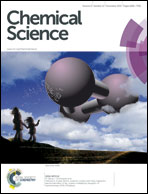Selective photocatalytic C–C bond cleavage under ambient conditions with earth abundant vanadium complexes†
Abstract
Selective C–C bond cleavage under ambient conditions is a challenging chemical transformation that can be a valuable tool for organic syntheses and macromolecular disassembly. Herein, we show that base metal vanadium photocatalysts can harvest visible light to effect the chemoselective C–C bond cleavage of lignin model compounds under ambient conditions. Lignin, a major aromatic constituent of non-food biomass, is an inexpensive, accessible source of fine chemical feedstocks such as phenols and aryl ethers. However, existing lignin degradation technologies are harsh and indiscriminately degrade valuable functional groups to produce intractable mixtures. The selective, photocatalytic depolymerization of lignin remains underexplored. In the course of our studies on lignin model compounds, we have uncovered a new C–C activation reaction that takes place under exceptionally mild conditions with high conversions. We present our fundamental studies on representative lignin model compounds, with the aim of expanding and generalizing the substrate scope in the future. Visible light is employed in the presence of earth-abundant vanadium oxo catalysts under ambient conditions. Selective C–C bond cleavage leads to valuable and functionally rich fine chemicals such as substituted aryl aldehydes and formates. Isotope labeling experiments, product analyses, and intermediate radical trapping, together with density functional theory studies, suggest a unique pathway that involves a photogenerated T1 state during the C–C bond cleavage reactions. Our study demonstrates a sustainable approach to harvest sunlight for an unusual, selective bond activation, which can potentially be applied in organic transformations and biomass valorization.



 Please wait while we load your content...
Please wait while we load your content...